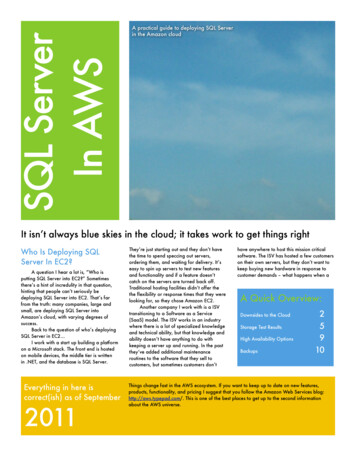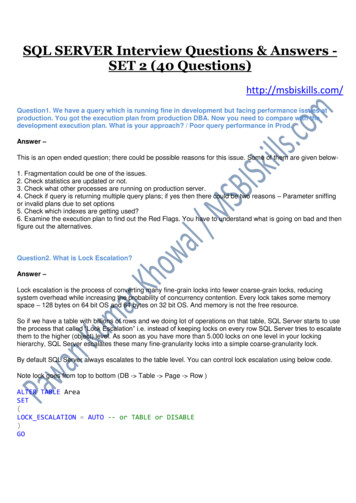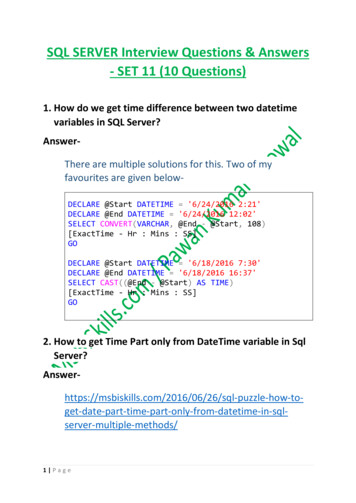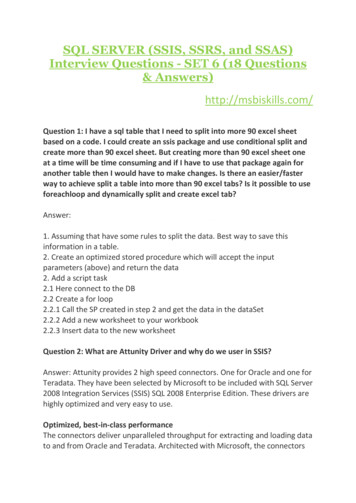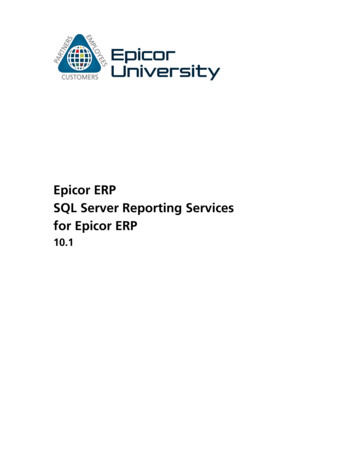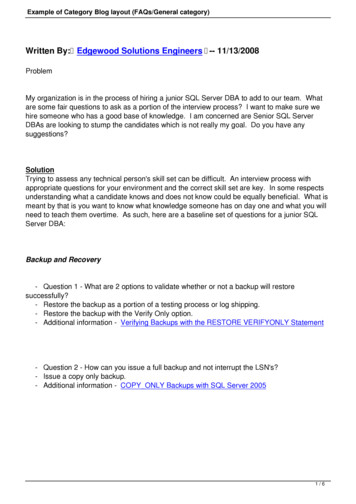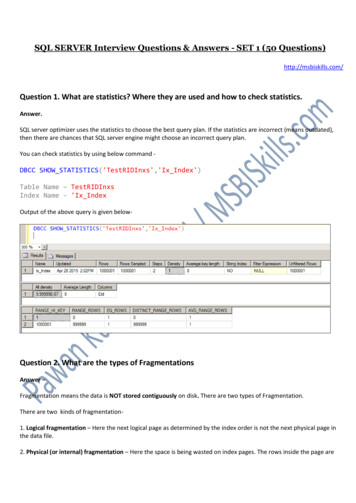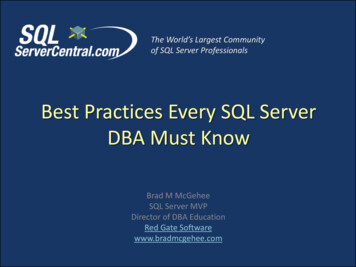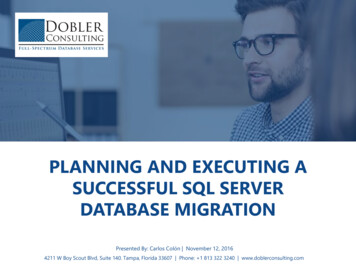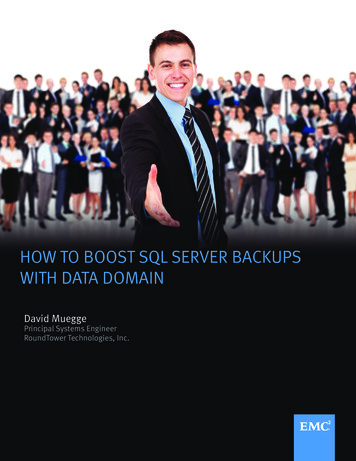
Transcription
HOW TO BOOST SQL SERVER BACKUPSWITH DATA DOMAINDavid MueggePrincipal Systems EngineerRoundTower Technologies, Inc.
Table of ContentsIntroduction . 5SQL Server Database Backup . 6The Common Dilemma . 6Backup Administrators View of SQL Server Backups and Restores . 6DBAs View of SQL Server Backups and Restores . 7The Common Approaches . 8Approach I: Backup Administrator Owns All Backups and Processes . 8Approach II: DBA Owns Database Backups and Processes .10Approach III: Backup Responsibilities Shared Between Backup Administrators and DBAs 12Data Domain and SQL Server Backups .14How Data Domain is Being Used Today for SQL Server .14Current Challenges.17Data Domain Boost for Microsoft Applications .18Benefits .18Challenges .18SQL Server Data Domain Boost Scripting Toolkit .19Prerequisite Configuration .20Toolkit Installation .20Catalog Table .20Stored Procedures .21Toolkit Usage .22Ad-Hoc Operations .23SQL Agent Jobs .28Maintenance Plans .32Toolkit Considerations .36Conclusion .362015 EMC Proven Professional Knowledge Sharing2
Appendix A: References .37Footnotes .37Bibliography .37About the Author .38Acknowledgments .38List of TablesTable 1: DDBMASQLCatalog SQL Table Structure .20Table 2: DDBMACatalog T-SQL Procedure Catalog Query Output Example .25List of FiguresFigure 1: Traditional Backup Application Managed by Backup Administrator . 8Figure 2: Native SQL Server Backups Managed by Database Administrator .10Figure 3: Traditional Backup Application and Native SQL Server Backup with SharedResponsibility .12Figure 4: Traditional Backup Application to Data Domain and Tape .15Figure 5: Native SQL Server Backups to Data Domain and Tape .16Figure 6: Native SQL Server Backups to Data Domain Only .17Figure 7: DDBMABackup T-SQL Procedure Full Backup Example.23Figure 8: DDBMABackup T-SQL Procedure Transaction Log Backup Example .23Figure 9: DDBMARestore T-SQL Procedure Normal Database Restore Example .24Figure 10: DDBMARestore T-SQL Procedure “NoRecover” Database Restore Example.24Figure 11: DDBMACatalog T-SQL Procedure Catalog Query Example .25Figure 12: DDBMACatalog T-SQL Procedure Catalog Delete Entries Example .26Figure 13: DDBMAExpire T-SQL Procedure Expired Images Query Example .26Figure 14: DDBMAExpire T-SQL Procedure Expired Images Query Output Example .27Figure 15: DDBMAExpire T-SQL Procedure Expired Images Delete Entries Example .27Figure 16: SQL Agent Job Backup Example .28Figure 17: SQL Agent Job Backup Advanced Settings Example .29Figure 18: SQL Agent Job Output History Example .30Figure 19: SQL Agent Job Multi-Step Backup and Restore Example .312015 EMC Proven Professional Knowledge Sharing3
Figure 20: SQL Agent Job Multi-Step Backup and Redirected Restore Example .32Figure 21: Maintenance Plan Creation Example .33Figure 22: Maintenance Plan Task Selection Example.33Figure 23: Maintenance Plan Task Order Example .34Figure 24: Maintenance Plan DDBMA Backup Example .34Figure 25: Maintenance Plan Final Configuration Example .35Figure 26: Maintenance Plan Step Details Example .35Code ConventionsThis article discusses topics relating to T-SQL programming. When names of SQL tables,scripts and procedures are used in headings, text, and descriptions they will be displayed inmonospace font.Disclaimer: The views, processes or methodologies published in this article are those of theauthor. They do not necessarily reflect EMC Corporation’s views, processes or methodologies.2015 EMC Proven Professional Knowledge Sharing4
IntroductionThe relational database management system (RDBMS) is a common and critical softwareapplication. Based on technology invented in 1970, RDBMS rose to widespread use in the1980s and 1990s. It is rare to find a business of any size that does not use some form ofrelational database.In enterprise information technology (IT) environments there is generally an infrastructure teamresponsible for the operation of hardware, such as servers and storage. The team is alsoresponsible for the operating system virtualization software layer. This team has responsibilityfor the reliability and integrity of the environment, as well as for the protection of the data itstores. Additionally, there are often one or more database administrators (DBAs) who managethe many tasks related to the data stored in relational databases. This team is concerned withthe accessibility, availability, and integrity of this data, which typically includes data protection.Since both teams have a shared interest in protection of the enterprise relational databases, thisleads to debate on how this important information should be protected.There are many backup product choices available and the major database vendors, such asMicrosoft and Oracle, have native tools for backup and recovery. A frequent debate seen inorganizations and across the IT industry is whether to use a traditional backup application oruse native tools provided by the database vendor.EMC provides multiple product options to accomplish backups of relational databases. Theseproducts are among the debated approaches to relational database backup. However, EMCData Domain is often the preferred choice for a disk-based backup and recovery storagesolution regardless of backup software technology. Microsoft SQL Server is a leading RDBMSand is widely deployed in many enterprises today. Data Domain is often used as a backuptarget for SQL Server.This article will discuss the common dilemma and approaches around Microsoft SQL Serverdatabase backups. It will provide information on how backup administrators and DBAs utilizeData Domain for SQL Server backups and introduce Data Domain Boost for MicrosoftApplications (DDBMA) as a solution that can enable both teams to meet their requirements. Thearticle aims to provide the SQL Server DBA with a foundation of knowledge for using DDBMA,including detailed guidance on how the DBA can maximize the usefulness of DDBMA using afreely available open source scripting toolkit. Topics include how to use the scripting toolkit withTransact-SQL query language (T-SQL), SQL Agent jobs, SQL Maintenance Plans, and DataDomain.2015 EMC Proven Professional Knowledge Sharing5
SQL Server Database BackupThe Common DilemmaIn many organizations, there is a challenge determining the best way to protect SQL Serverdatabases. There are commonly two teams concerned with protecting SQL Server databases;backup administrators and SQL Server DBAs. Most backup administrators prefer to usetraditional backup applications and most SQL Server DBAs prefer to use the native backuptools. The debate between the teams is usually grounded in the lack of understanding eachteam has of the other’s requirements.The sections below provide information to better understand the point-of-view of each team.Backup Administrators View of SQL Server Backups and RestoresThe backup administrator is generally concerned with a variety of requirements such as: Backup and restore reliability Backup and restore speed Software ease of use Media and device support Media management capabilities Operating system and application support Monitoring, notifications, and reportingMany traditional backup applications provide these features and are the preferred tool forbackup administrators. Since SQL Server backups are only one part of the infrastructure theyare required to protect, the backup strategy they choose must include all of the above items formultiple systems and applications.2015 EMC Proven Professional Knowledge Sharing6
DBAs View of SQL Server Backups and RestoresThe SQL Server DBA is generally concerned with protection of the SQL databases, but alsoconcentrates on other processes that use backup and restore operations. The DBA is usuallyfocused on the requirements listed below: Backup and restore reliability Backup and restore speed Software ease of use Automation capabilities oIntegration with other SQL Server processesoT-SQL scriptingMonitoring, notifications, and reportingWhile DBAs have some of the same concerns as backup administrators, they view the problemas one best solved by the native SQL Server tools. Often, DBAs view traditional backupapplications as unnecessary, unreliable, and difficult to integrate with other databasemaintenance processes.The next section will discuss three of the most common approaches to SQL Server dataprotection.2015 EMC Proven Professional Knowledge Sharing7
The Common ApproachesThere are various approaches to SQL Server backups. The three approaches seen most oftenin IT environments will be discussed.Approach I: Backup Administrator Owns All Backups and ProcessesIn this approach, a traditional backup application is used to perform all backups and restores ofSQL Server databases. The backup administrator manages all backup and restore operations.This method is common in smaller IT environments without dedicated DBAs, or in environmentsthat do not engage in application development or customization. In this case, more complexoperations performed by DBAs, such as refreshing development and testing databases, are notrequired. Figure 1 illustrates how this approach is generally deployed.Figure 1: Traditional Backup Application Managed by Backup Administrator2015 EMC Proven Professional Knowledge Sharing8
In this scenario only periodic full and incremental backups are required and more complexrequirements are not needed. Commonly debated pros and cons of this approach are:Pros Centralized reporting and scheduling of all backups Integrated catalog and media management Delegated backup and restore functionality via role-based access control Deduplicated and compressed backup data Widely supported operating systems and applications Agents to provide application consistent backupsCons DBAs are not able to use familiar tools DBAs will tend to perform additional backups to disko Increases storage space requirementsDBAs must be concerned with how primary backups are handled when completingoperations due to backup chain and scheduling oRestoring production to development or testing databasesoLog shipping to standby serversComplexity added due to the necessary integration of backups with maintenance tasksThis approach presents challenges for the DBA as the complexity of the SQL Serverenvironment increases. This generally results in the DBA performing backups outside of thenormal procedures, which duplicates data. This practice can also cause issues with the backupchain of full and incremental or differential backups, which can jeopardize the reliability ofrestores. These situations can result in duplicated effort, inefficient use of resources, reducedreliability, and higher costs for the organization.2015 EMC Proven Professional Knowledge Sharing9
Approach II: DBA Owns Database Backups and ProcessesIn this approach, the SQL Database Administrator owns all backups and processes related toSQL Server databases. This method is common in more complex SQL Server environmentswhere backup processes must be integrated with other SQL Server database maintenancetasks, such as rebuilding indexes and updating database statistics. Figure 2 illustrates how thisapproach is generally deployed.Figure 2: Native SQL Server Backups Managed by Database AdministratorDBAs often script backup and maintenance tasks together in SQL Agent jobs and MaintenancePlans, which provides automation and notification. It is also common for the DBA to place allbackup files from SQL Server on a file server to be picked up later by a traditional backupapplication.2015 EMC Proven Professional Knowledge Sharing10
Pros DBAs have greater level of control over backup processes DBAs can use backups in other processes, such as log shipping for standby anddisaster recovery DBAs greater flexibility to utilize backup and restore in software development lifecycle Integration with other database maintenance processes is increased Allows for rapid ad-hoc backup and restore functionalityCons Monitoring and reporting of backups is not centralizedo Additional work for auditsData needs to be backed up twice to write to tapeoAdditional tape backup hardware could be installed in SQL servers, but this addscomplexity and is difficult in virtualized environments SQL Server native backup tool lacks a backup catalog and media managementcapabilitiesThis approach provides DBAs the control and flexibility they desire, but has shortcomings for theinfrastructure team. They have less visibility into SQL Server backups and face difficulties withreporting and audits. This method also presents challenges for tape media management, asSQL Server backups are typically only files included in the file server backup where disk-basedSQL backups are written.2015 EMC Proven Professional Knowledge Sharing11
Approach III: Backup Responsibilities Shared Between Backup Administrators and DBAsIn some cases, responsibilities for SQL Server data protection is shared between two teamsand duplication of effort and data is accepted to meet the needs of both teams. While thisapproach can balance the pros and minimize the cons of the previous two approachesmentioned, there can still be a few challenges. Monitoring and reporting is done by multiple systems Backup chain can be more difficult to maintainoRestores can be more difficult and less reliable Complexity is generally increased Increased time to complete backups for long-term storageWhile the teams will still face challenges with this approach, it is very common to see some formof shared approach is being used in environments where SQL Server is used extensively.Figure 3 illustrates how this approach is generally deployed.Figure 3: Traditional Backup Application and Native SQL Server Backup with Shared Responsibility2015 EMC Proven Professional Knowledge Sharing12
There are ways to use this approach successfully, but good communication between the teamsand effective use of various tools is required. An important element in using this approach is tohave a thorough understanding of both approaches to SQL Server backup and the tools usedby each team. By having this understanding, risks to the SQL Server backup chain can bereduced to maintain restore reliability with minimal duplication of effort and resources. This willalso allow both teams to accomplish their respective goals.The next section will talk about Data Domain; how it is being used in environments today forSQL Server backups, and how it can be used to maximize backup productivity and minimizebackup data storage requirements.2015 EMC Proven Professional Knowledge Sharing13
Data Domain and SQL Server BackupsData Domain is a purpose-built backup appliance used by many organizations to store backupdata. It has many benefits, including data deduplication and optimized replication. This allowsfor optimal space utilization in required disk storage and provides an efficient mechanism tomove data offsite. Backup data is deduplicated and compressed prior to replication over thenetwork.The Data Domain appliance can be used as a Common Internet File System (CIFS)/ServerMessage Block (SMB) or Network File System (NFS) file share. Data Domain can also beintegrated into various traditional backup applications. This makes it an excellent option forenterprises to use as a target for a wide range of backup applications.How Data Domain is Being Used Today for SQL ServerData Domain is being used in many environments to protect SQL Server data. Theseenvironments generally use one of the common approaches discussed in the previous section.One critical factor to consider before choosing an approach is whether the use of tape media isrequired. While Data Domain can use an archive tier and provide long-term retention of backupdata, some organizations prefer to use tape media if long-term retention is required. Thepreference to us
Jan 02, 2015 · EMC provides multiple product options to accomplish backups of relational databases. These products are among the debated approaches to relational database backup. However, EMC Data Domain is often the preferred choice for a disk-based backup and recovery s



